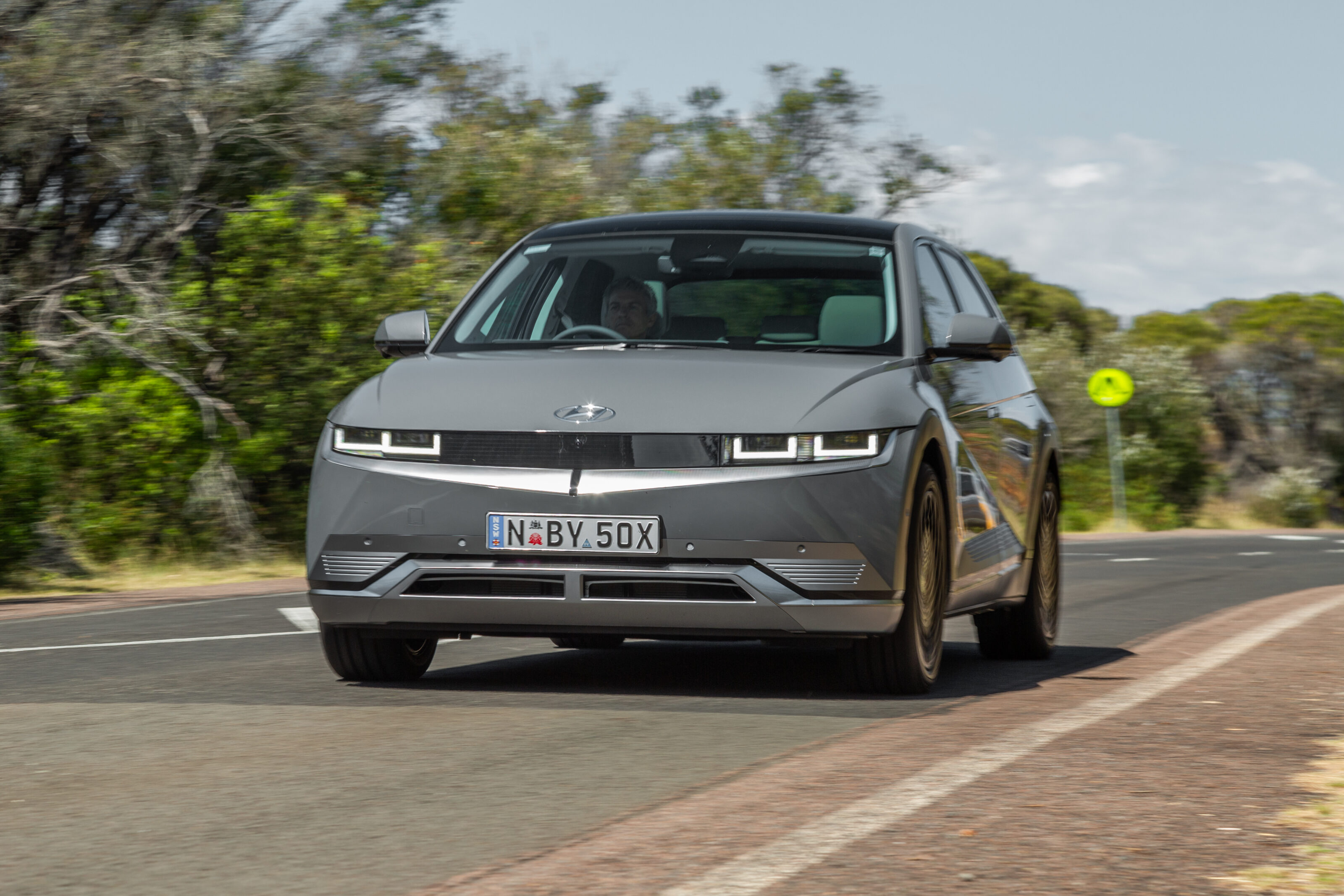Score breakdown
Things we like
- Ultra-rapid charging capability
- Bi-directional charging function
- Fantastically spacious and practical cabin
- Interior’s quality and eco-friendly trim
Not so much
- No app functionality or HUD yet
- Intrusive Lane Keep system
- Ride not always settled
- Pricing misses out on best EV incentives
March 2024: Updated 2025 IONIQ 5 revealed
Hyundai’s big IONIQ 5 electric SUV will welcome a sports-styled N Line grade this year, arriving in Australia from around the middle of 2024.
REVIEW: 2022 Hyundai IONIQ 5
It’s frenetic times in the Hyundai Motor Group’s product planning department.
A fast-expanding range of performance cars is finally following the critically acclaimed i30 N hot hatch, while a raft of higher-brow models has been drafted in to bolster the germinal Genesis luxury brand.
Now it’s the turn of EVs. Put aside the electric Kona and non-numerical electric IONIQ models of recent years, however, and ignore Hyundai’s dabbles with hydrogen fuel cells; the IONIQ 5 is where the company is getting properly serious about electrification.
The 5 is the first of a new IONIQ sub-brand range that must give Hyundai a solid footing in a market now making its inevitable transition away from petroleum.
There’s a new dedicated modular battery electric vehicle platform underneath, which will be shared with numerous future models including the Kia EV6 and Genesis GV60.
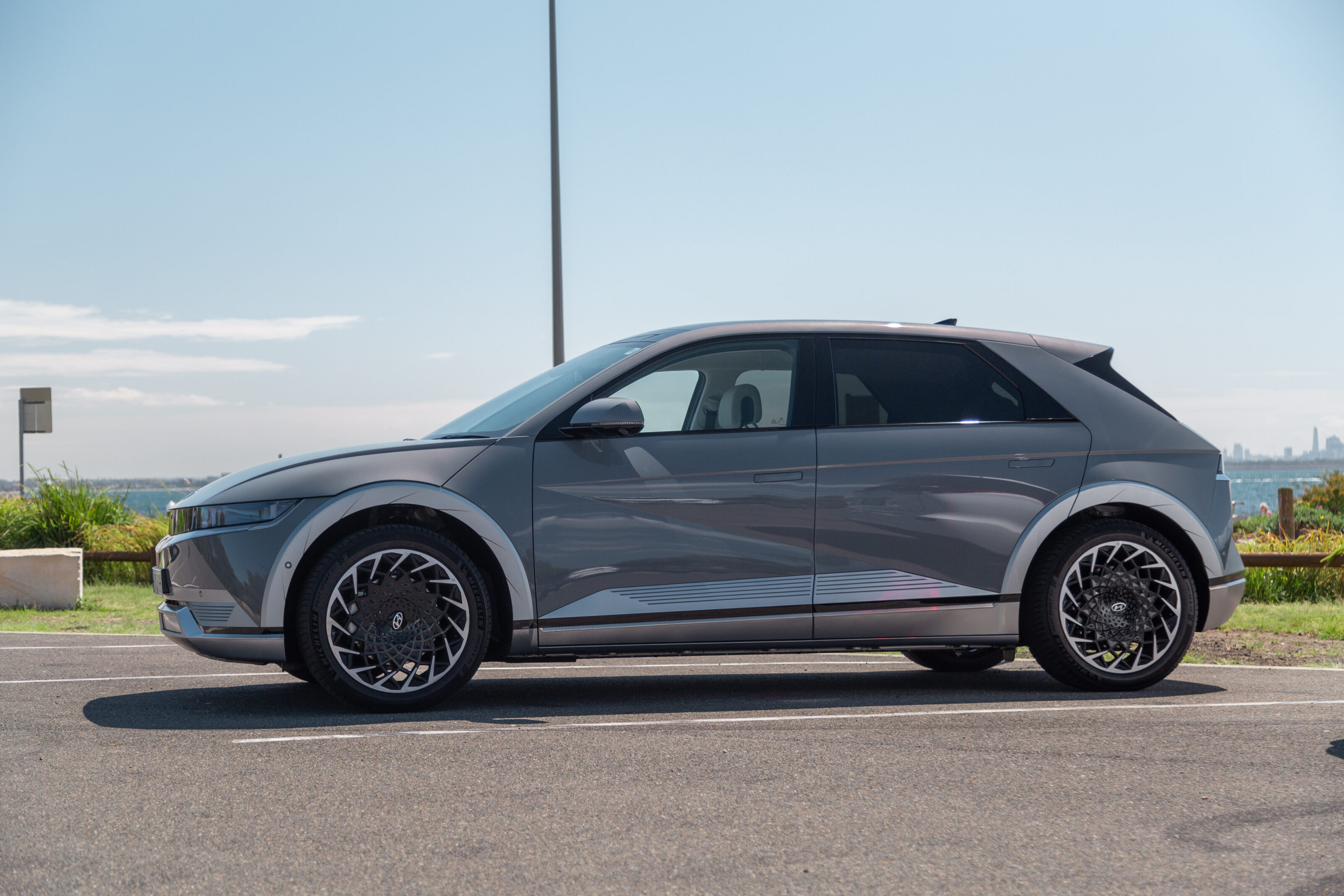
Naturally, however, it’s the IONIQ 5’s tautly chiselled, retro-futuristic overlay – with more than a hint of Lancia Delta Integrale about its shape – that has captured widespread attention.
The shrink-wrap bodywork and short overhangs disguise the real-world size of a five-door crossover body style that is much larger than pictures suggest.
Measuring 4635mm long, the IONIQ 5 is fractionally longer than the Tucson mid-size SUV. The three-metre wheelbase is longer than that of Hyundai’s largest SUV, the Palisade.
This lends perspective to pricing that makes the IONIQ 5 – in $75,900 AWD form, at least – the most expensive model currently in Hyundai showrooms. (Although don’t go to a Hyundai dealership to buy it yet, because the initial 400 units are being sold exclusively online.)
There’s a slightly more affordable, $71,900 RWD version available now with less performance but stacked with a big pile of standard features just like the dual-motor model.
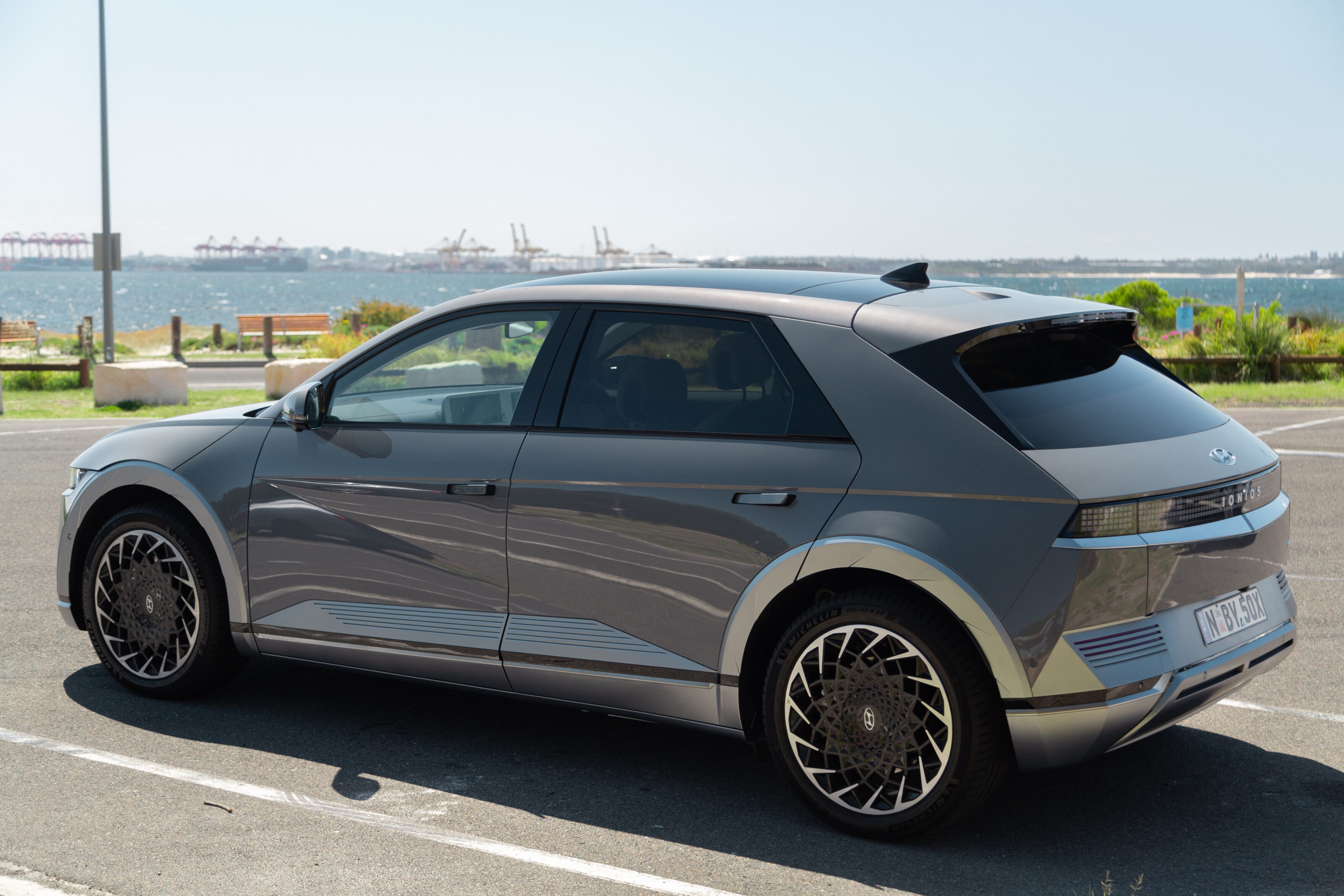
Equipment highlights include 20-inch alloy wheels, LED lamps front and rear, fixed glass sunroof, smart tailgate, electrically adjustable front seats with heating/ventilation, heated and electrically adjustable rear seats, heated steering wheel, dual 12.3-inch dash displays, surround-view cameras, and a Bose audio system.
Given it’s currently priced beyond access to the best EV subsidies currently available in Australia – in NSW and Victoria – you’ll need to wait until 2022 for an entry-level IONIQ 5. This version will feature a smaller battery but is expected to be priced closer to the cheapest Tesla Model 3, which starts from just over $60,000.
At the other end of the budget spectrum, spy shots tell us an IONIQ 5 N will eventually top the range.
It’s the IONIQ 5’s tautly chiselled, retro-futuristic overlay – with a hint of Lancia Delta Integrale about its shape – that has captured widespread attention.
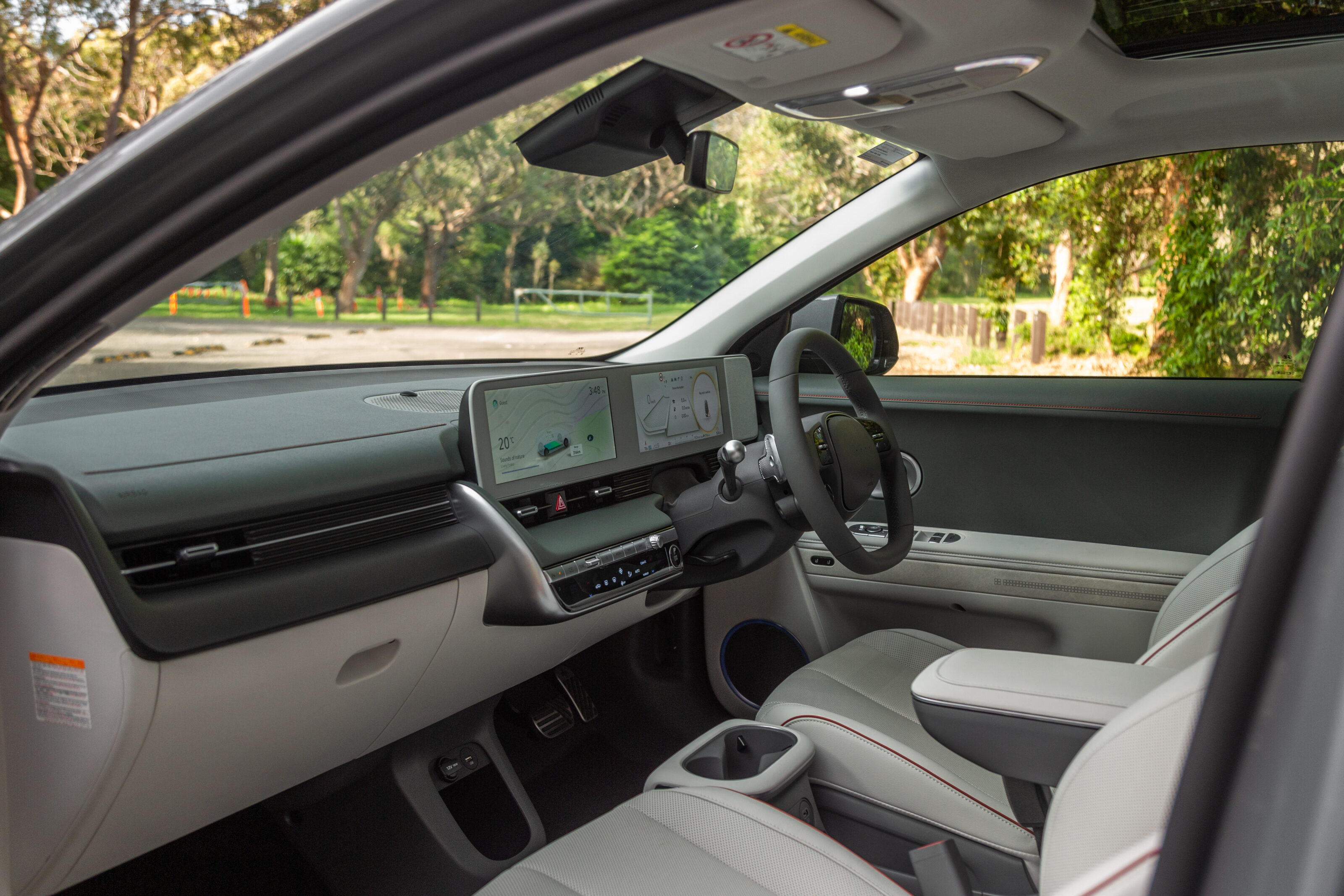
That limo-like wheelbase promises big interior space, and the IONIQ 5 doesn’t disappoint.
The front cabin is given an extra sense of roominess with the completely flat floor and a centre console that can be slid backwards to create a virtual walkthrough between the front seats.
It’s bright, too, at least with our test car’s light, dual-tone trim. Especially if the sunroof blind is opened to reveal the wonderfully expansive glass ceiling.
The impression of quality isn’t quite on the same level of poshness as, say, the similarly priced Genesis GV70 SUV, but it’s comfortably above the Hyundai norm.
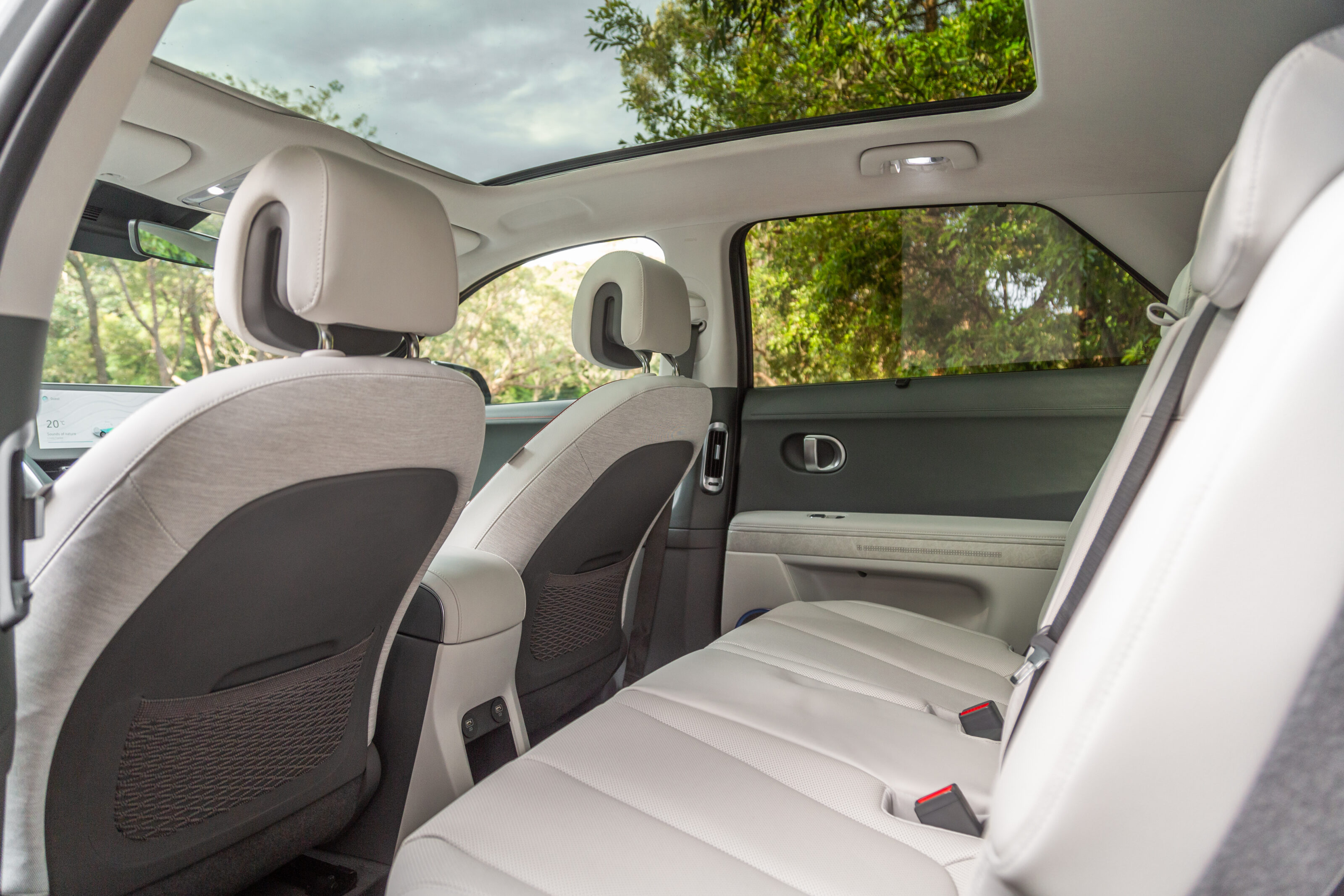
There’s some extra emphasis on eco materials, including a recyclable paperette door trim, bio-painted interior surfaces, and veggie-oil-treated leather upholstery.
Also lending the IONIQ 5 a distinctive in-house look is the dash design, including some Mercedes-aping features such as the conjoined 12.0-inch digital displays and transmission wand (the chunkiest of a trio of chubby stalks).
Something next to the driver display you don’t get in a Benz, though – a magnetic pin-up board that I initially mistook for an extra speaker. Apparently, it’s so owners can attach a photo of their partners or family.

Unhampered by a traditional central tunnel, the large ‘Universal Island’ centre console has an open area large enough for a small bag or pair of shoes. The upper lidded box doubles as an armrest that can be lifted out of the way, and the lower tray area includes inductive smartphone charging.
Where are the USB-C ports, though? USB-As are old-tech these days. Over-the-air updates are limited to the navigation system, too, where Teslas have wider potential to be improved by rolling software upgrades.
And no one-touch rear windows is a minor thing that seems like a major omission in an electric car.
The glovebox is ingenious – a pull-out drawer that’s big enough to hold a 13-inch laptop.
Another nice interior detail; the accelerator and brake pedals respectively feature Plus and Minus symbols.
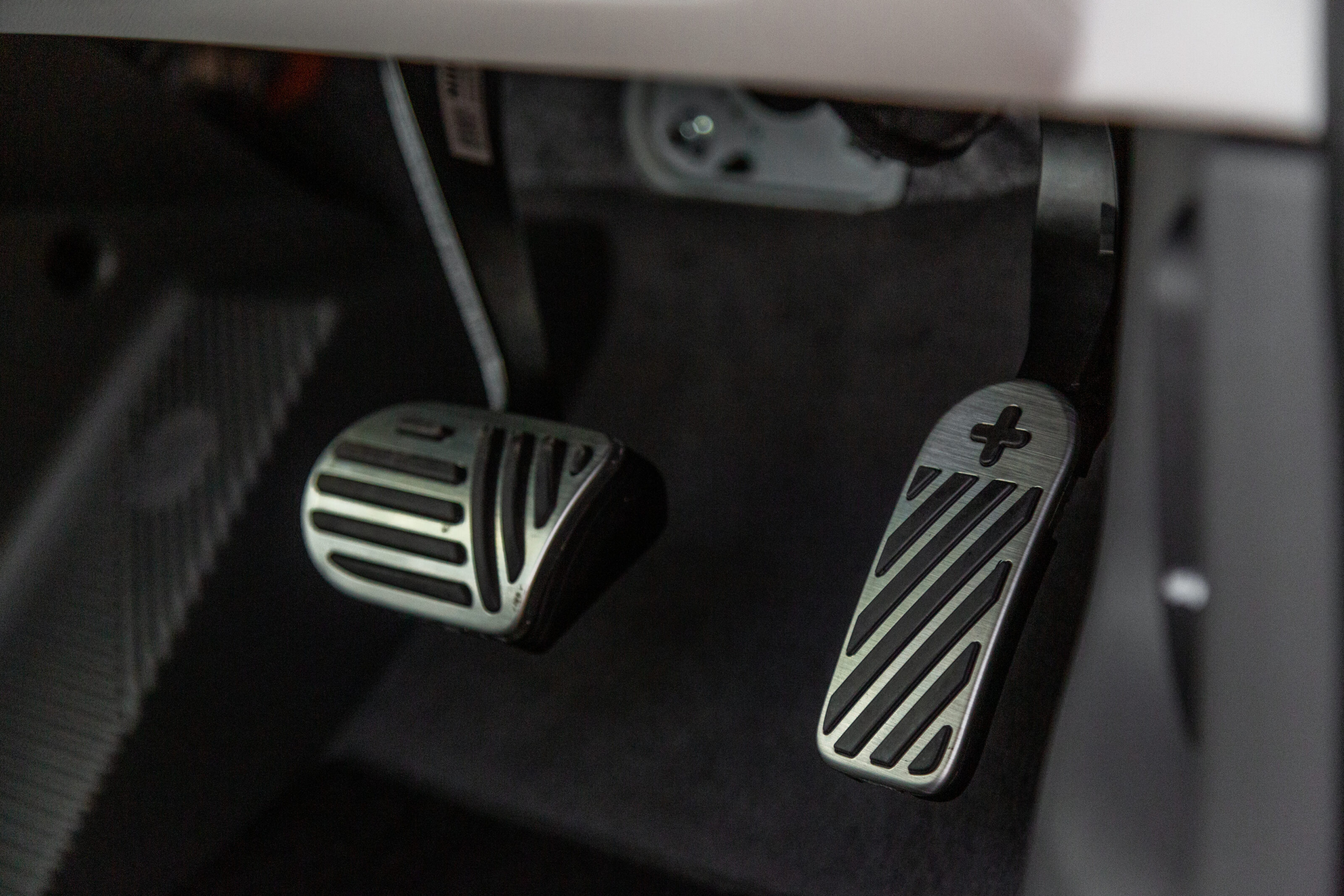
A big rear door provides wide ingress/egress to a VIP-like rear seat with considerable knee space – more than a metre – and plenty of electric adjustment.
Unfortunately, Australian IONIQ 5s miss out on a power socket beneath the rear seats that can turn the car into a rolling power bank.
This Vehicle to Load (V2L) power source technology is available when stationary, however. An adaptor stored under the boot floor plugs into the vehicle’s exterior recharging port, allowing various electrical appliances to be plugged into a 250V/15A socket on the other end.
Aside from the likes of laptops and camping gear such as air pumps, the V2L connector allows the IONIQ 5 to give another EV a quick battery boost. The Hyundai cuts off the V2L when the car’s battery gets down to 44 per cent.

Two different sets of recharging plugs were provided under the boot floor of our test car, each representing an extreme of possible topping-up speeds – from glacial to rapid.
One connects the IONIQ 5 to a conventional power socket but would take more than a day, according to the onboard computer, to add about 33 per cent charge.
The other takes advantage of the 5’s 800V charging capability that’s double the industry standard for EVs and currently shared only with the Porsche Taycan and upcoming Audi E-Tron GT.
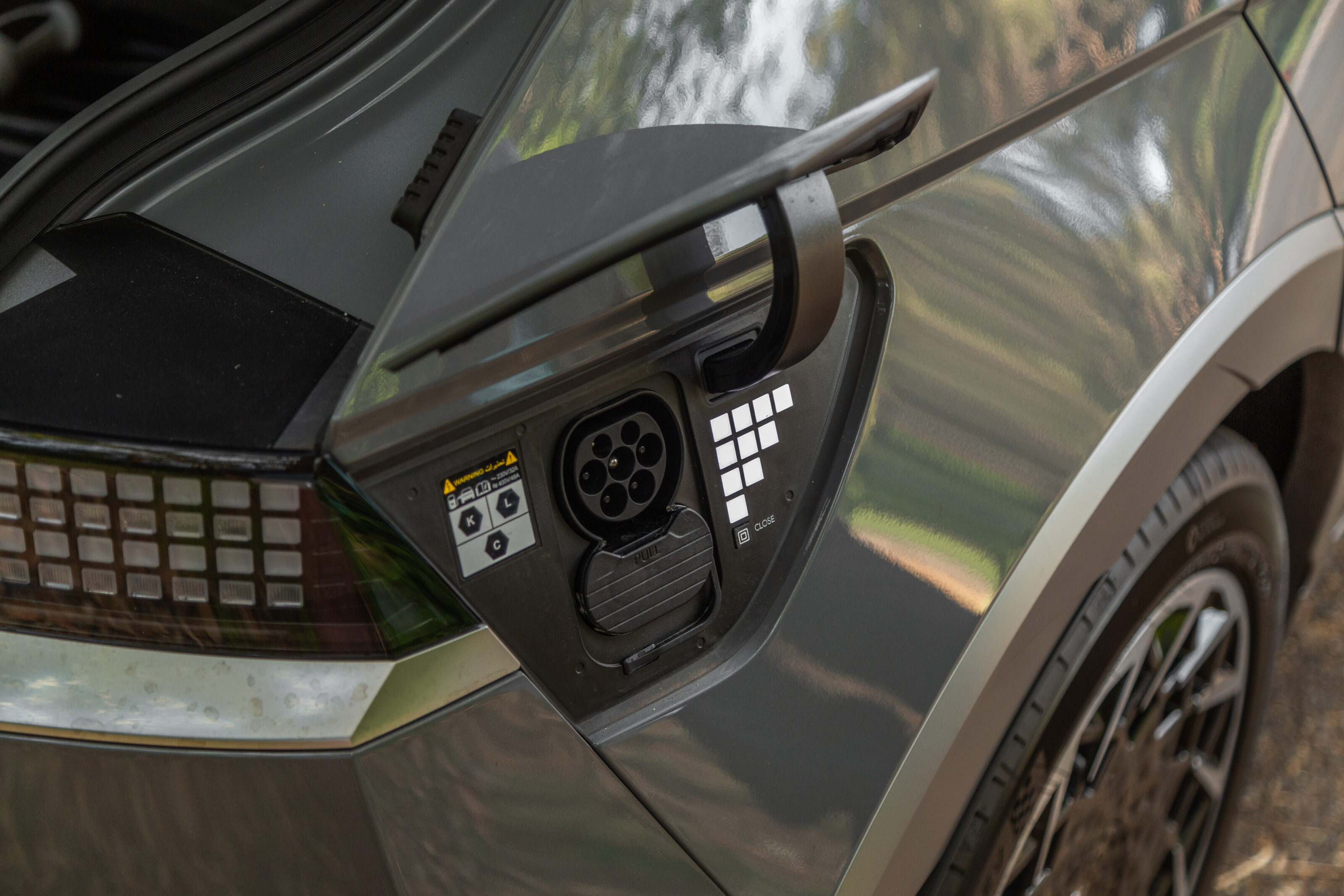
This makes the IONIQ 5 one of the fastest-replenishing EVs around when hooked up to a 350kW DC ultra-fast charger, with a 10-80 per cent charging time of just over 17 minutes. In range terms, 100km can be added in just five minutes.
The big caveat is that, in Australia, these super-rapid charging points are extremely thin on the ground.
Using the vehicle’s 10.5kW AC onboard charger with a wall box type home charging point takes just over six hours.
This makes the IONIQ 5 one of the fastest-replenishing EVs around when hooked up to a 350kW DC ultra-fast charger. In range terms, 100km can be added in just five minutes.

Hyundai quotes 527 litres of luggage capacity beneath the steeply raked tailgate – a figure that puts the IONIQ 5 in the mix with mid-sized SUVs. That’s just 12 litres shy of the company’s own Tucson, for example.
The boot is relatively shallow, though, and the (removable) cargo blind is positioned lower than the top of the seatbacks. Those seatbacks fold down flat if more space is required and not all rear seats are in use.
As with many EVs, there’s a bonus ‘frunk’ space under the bonnet where a bulky internal combustion engine would usually reside. It’s most useful in the RWD version where there’s 57 litres; the AWD’s front electric motor reduces it to a measly 24 litres.

Both the RWD and AWD IONIQs feature a 73kWh lithium-ion battery pack beneath the floorpan, with the single-motor model producing 160kW and 350Nm and the dual-motor dishing out 225kW and 605Nm.
Hyundai quotes 5.2 seconds for the AWD IONIQ’s 0-100km/h performance.
While the fastest IONIQ 5 is half a second slower than the forthcoming Polestar 2 Dual-Motor and nearly two seconds behind the rather absurd 3.3 seconds of the Tesla Model 3 Performance, few will ever consider the Hyundai slow – especially when Sport mode is selected to make the front motor a constant rather than part-time contributor.
Thus engaged, the AWD IONIQ pins occupants into their seats under full throttle – a sensation not replicated in the RWD version.
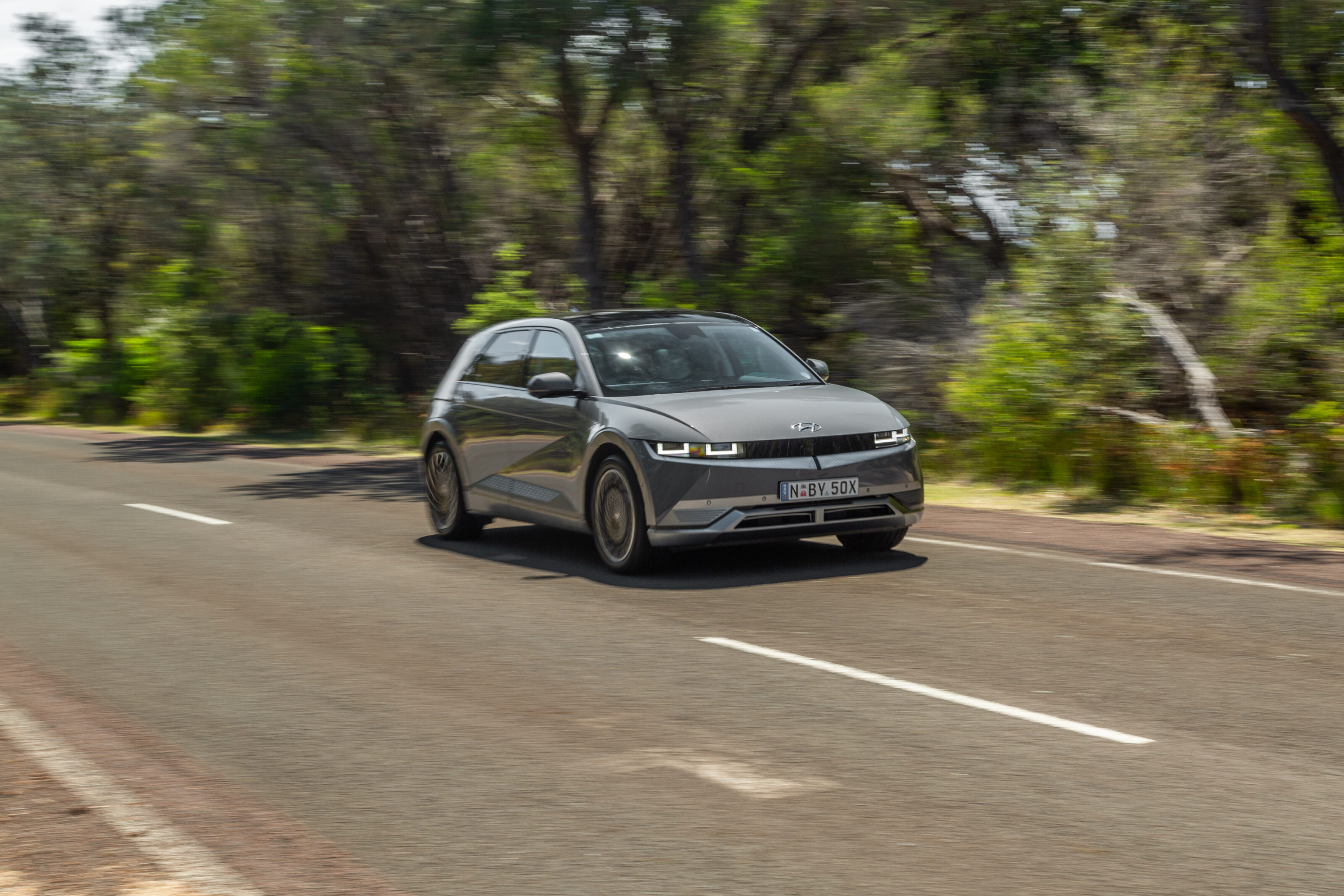
However, Normal mode – which decouples the front electric motor to save energy when not required – is more than satisfactory for general driving, with all the instantaneously smooth acceleration that is the hallmark of EV drivetrains.
Eco mode dulls throttle response and helps maximise range – a figure that is provided permanently in the driver display along with battery percentage.
Reassuringly, the range estimations proved sufficiently accurate during testing. Over a 145km drive with a mix of roads, the IONIQ 5 AWD used up 150km. Battery life takes a bigger hit on longer freeway stints. A separate drive in the RWD version – involving mostly freeway (and a cooler day) – used 339km of range for a 229km trip.
While the fastest IONIQ 5 is nearly two seconds behind the Model 3 Performance, few will ever consider the Hyundai slow.

The infotainment menu includes an EV page providing additional information, including distance to the nearest charging station (which seemed less accurate at times) as well as the number of extra kilometres possible by switching off the climate control.
While the RWD version will travel an extra 21km based on Europe’s WLTP test cycle, its 451km range still falls well short of the ballpark-priced ‘Long Range’ Model 3 and Polestar 2 – 580km and 540km, respectively.
A 481km-range variant using smaller 19-inch wheels is also expected, though even the AWD’s 430km will be more than sufficient for most owners, especially those with a second (non-EV) vehicle.
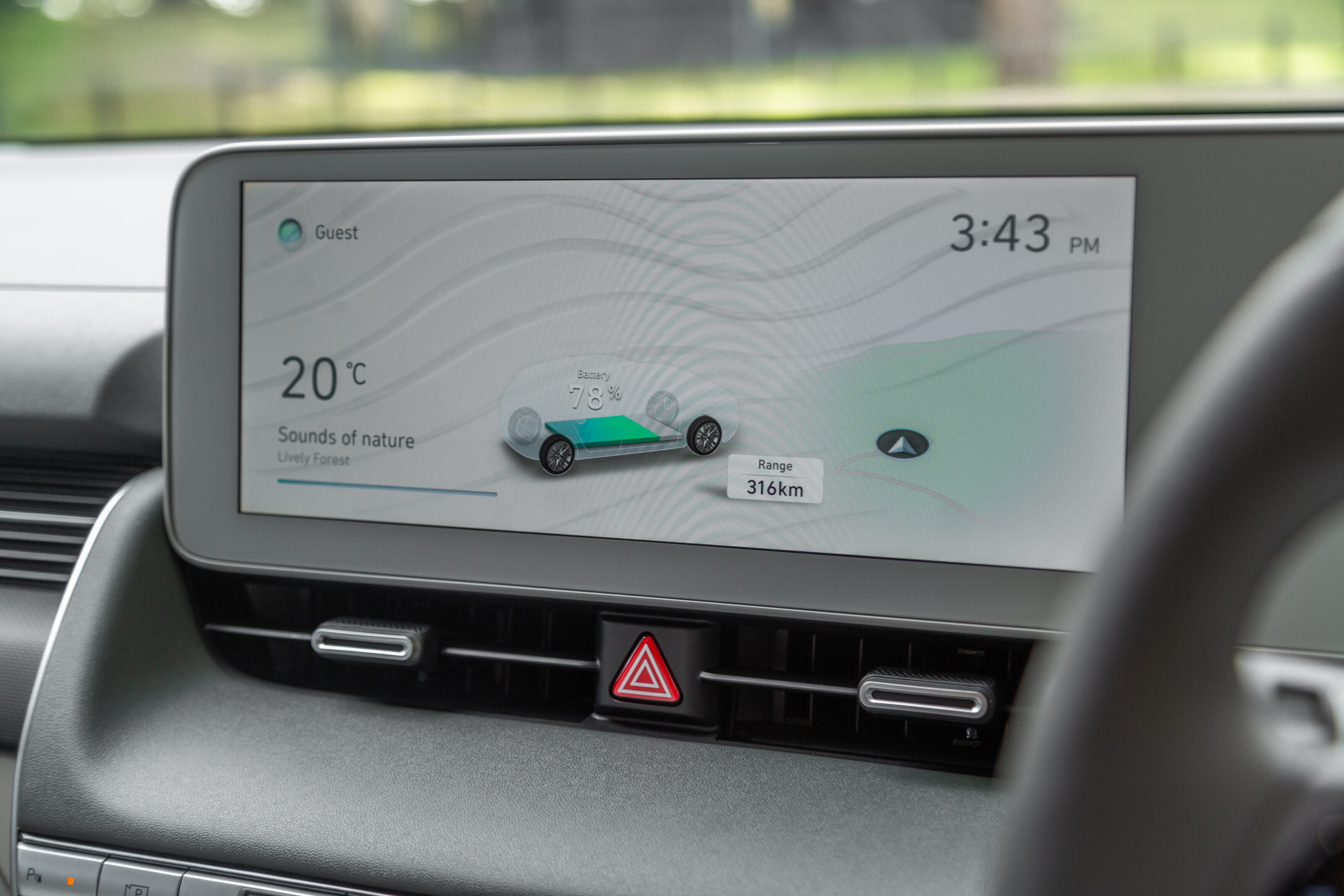
The battery platform helps create a low centre of gravity, so the IONIQ 5 is quite adept at directional changes despite its 2100kg kerb weight.
There’s not too much body roll and there’s enjoyment to be had in using the accelerator pedal only even on country roads – rolling off it for a trail-braking effect via the regen braking, then rolling back onto it with firm pressure to savour the AWD’s slingshot bursts out of corners.
Steering is also at its best with more lock wound on. Otherwise, there’s some unnatural resistance off the straight-ahead position that slightly spoils the rack’s fluidity.
A much bigger blemish is the intrusive Lane Keep Assist system that, above 60km/h, is determined to interfere unnecessarily with the steering. While it can be switched off via a steering wheel button, it’s reactivated every time the car is restarted.
The 20-inch wheels look great but can thud into potholes and bring some firmness to the low-speed ride. But the suspension otherwise deliver a pleasant suppleness, with the IONIQ 5 just getting fidgety on particularly uneven roads.
Servicing costs are $220 every year or 15,000km, with the exception of the 48-month/60,000km visit that asks a steeper $804. The car is covered by a five-year warranty; the battery is covered for eight years or 160,000km.

It will be interesting to see how the IONIQ 5 range develops in 2022 with cheaper variants or different trim grades.
The introduction of missing-for-now tech, including the Bluelink smartphone app, would certainly help Hyundai get closer to Tesla’s cleverly convenient EV ownership experience.
Right now, though, the IONIQ 5 is already a highly enticing EV.
2021 Hyundai IONIQ 5 specifications
| Body | 5-door hatch |
|---|---|
| Electric motors | Single rear (RWD) / Dual (AWD) |
| Battery | 72.6kWh lithium-ion polymer |
| Transmission | Single-speed reduction gear |
| Power | 160kW (RWD) / 225kW (AWD) |
| Torque | 350Nm (RWD) / 605Nm (AWD) |
| 0-100km/h (claimed) | 7.4 seconds (RWD) / 5.2 seconds (AWD) |
| Consumption (rated) | 17.9kWh/100km (RWD) / 19.0kWh/100km (AWD) |
| Weight | 2020kg (RWD) / 2100kg (AWD) |
| Suspension | Front struts; rear multilink |
| L/W/h | 4635/1890/1605mm |
| Wheelbase | 3000mm |
| Boot space | 527L |
| Frunk space | 57L (RWD) / 24L (AWD) |
| Brakes | 345mm ventilated (front and rear) |
| Tyres | 255/45R20; Michelin Pilot Sport EV |
| Price | $71,900rrp (RWD) / $75,900rrp (AWD) |
Score breakdown
Things we like
- Ultra-rapid charging capability
- Bi-directional charging function
- Fantastically spacious and practical cabin
- Interior’s quality and eco-friendly trim
Not so much
- No app functionality or HUD yet
- Intrusive Lane Keep system
- Ride not always settled
- Pricing misses out on best EV incentives


